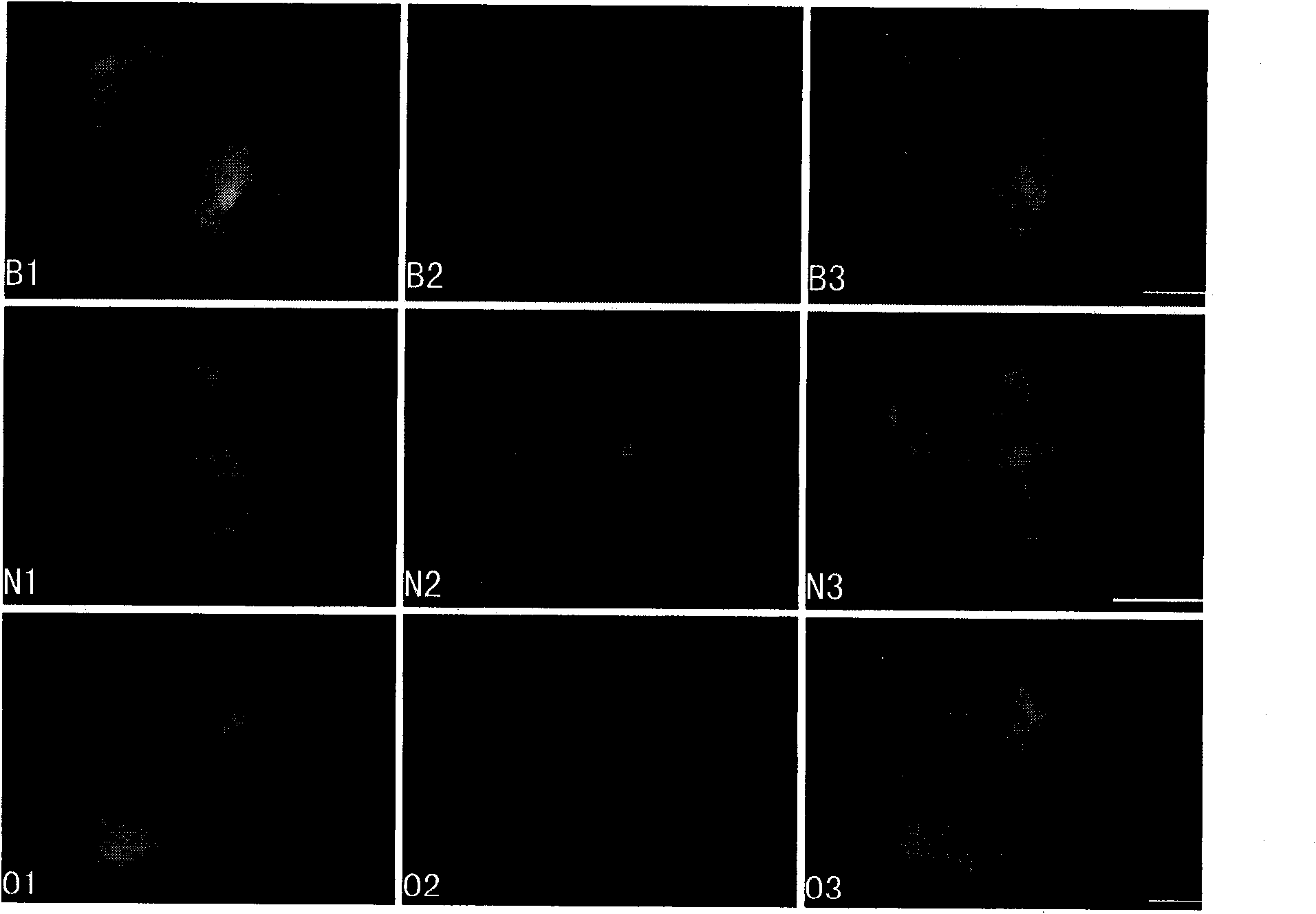Immunofluorescence method for rapidly detecting nucleolus protein positioning under the stress of heavy metal
A detection method, immunofluorescence technology, applied in the field of cell biology
- Summary
- Abstract
- Description
- Claims
- Application Information
AI Technical Summary
Problems solved by technology
Method used
Image
Examples
Embodiment 1
[0073] Material culture takes broad bean as an example: when the main (side) root of broad bean is about 1.5cm long, use 10μM, 50μM, 100μM Cd 2+ Treatment 24h, 48h, 72h.
[0074] (1) Cut out the root tip meristem cells of Vicia faba plant after heavy metal treatment, fix in 4% paraformaldehyde for 2 hours; wash with PBS buffer solution;
[0075] (2) Use 2.5% cellulase + 2.5% pectinase enzyme solution to enzymolyze in a 37°C incubator; wash with PBS buffer and press into tablets;
[0076] (3) Transfer the root tip of the faba bean plant to a centrifuge tube, add PBS buffer solution dropwise, shake it by hand until most cells are free, use a dropper to absorb about 0.1ml of sample solution, and spread it evenly on a glass slide to disperse into single cells. After marking, let it air dry naturally for later use;
[0077] (4) soak the glass slide obtained in (3) in 1% TritonX-100 for 15 minutes; wash with PBS buffer;
[0078] (5) Drop 15 μl of the prepared primary antibody on ...
Embodiment 2
[0084] Material cultivation Taking garlic as an example, when the adventitious root of garlic is about 1.5cm long, use 10μM, 50μM, 100μM Pb 2+ Treatment 24h, 48h, 72h. Pb
[0085] Experimental steps:
[0086] (1) Cut out about 2 mm of the root tip after the heavy metal treatment, and fix it in 4% paraformaldehyde for 2 hours.
[0087] (2) Wash in PBS buffer (pH 7.0) 3 times (10 minutes each time).
[0088] (3) 2.5% cellulase + 2.5% pectinase, 37 ° C incubator enzymatic hydrolysis, microscopic inspection at any time during the enzymatic hydrolysis, until a large number of spherical protoplasts are produced to end the enzymatic hydrolysis.
[0089] (4) Wash with PBS buffer 3 times (10 minutes each time).
[0090] (5) Transfer the root tip to a 0.5ml centrifuge tube, add a small amount of PBS buffer dropwise (depending on the size of the sample), cover the centrifuge tube, shake it by hand until most cells are free. Use a dropper to draw about 0.2ml of sample solution, apply...
Embodiment 3
[0102] Changes of Nucleolar B23 Protein in Onion Root Tip Cells
[0103] Material culture takes onion as an example: when the adventitious root of onion is about 1.5cm long, use 10μM, 50μM, 100μM Al 3+ Treatment 24h, 48h, 72h.
[0104] Experimental steps:
[0105] (1) Cut out about 2 mm of the root tip after the heavy metal treatment, and fix it in 4% paraformaldehyde for 2 hours.
[0106] (2) Wash in PBS buffer (pH 7.0) 3 times (15 minutes each time).
[0107] (3) 2.5% cellulase + 2.5% pectinase, 37 ° C incubator enzymatic hydrolysis, microscopic inspection at any time during the enzymatic hydrolysis, until a large number of spherical protoplasts are produced to end the enzymatic hydrolysis.
[0108] (4) Wash with PBS buffer 3 times (15 minutes each time).
[0109] (5) Transfer the root tip to a 0.5ml centrifuge tube, add a small amount of PBS buffer dropwise (depending on the size of the sample), cover the centrifuge tube, shake it by hand until most cells are free. Use...
PUM
 Login to View More
Login to View More Abstract
Description
Claims
Application Information
 Login to View More
Login to View More - R&D
- Intellectual Property
- Life Sciences
- Materials
- Tech Scout
- Unparalleled Data Quality
- Higher Quality Content
- 60% Fewer Hallucinations
Browse by: Latest US Patents, China's latest patents, Technical Efficacy Thesaurus, Application Domain, Technology Topic, Popular Technical Reports.
© 2025 PatSnap. All rights reserved.Legal|Privacy policy|Modern Slavery Act Transparency Statement|Sitemap|About US| Contact US: help@patsnap.com


